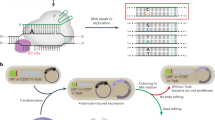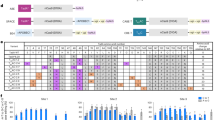Abstract
Here we developed an adenine transversion base editor, AYBE, for A-to-C and A-to-T transversion editing in mammalian cells by fusing an adenine base editor (ABE) with hypoxanthine excision protein N-methylpurine DNA glycosylase (MPG). We also engineered AYBE variants enabling targeted editing at genomic loci with higher transversion editing activity (up to 72% for A-to-C or A-to-T editing).
This is a preview of subscription content, access via your institution
Access options
Access Nature and 54 other Nature Portfolio journals
Get Nature+, our best-value online-access subscription
$29.99 / 30 days
cancel any time
Subscribe to this journal
Receive 12 print issues and online access
$209.00 per year
only $17.42 per issue
Buy this article
- Purchase on Springer Link
- Instant access to full article PDF
Prices may be subject to local taxes which are calculated during checkout


Similar content being viewed by others
Data availability
Expression plasmids used in this study have been deposited at Addgene and will be available at https://www.addgene.org/Huawei_Tong/ (Addgene plasmid nos. 193966–193968). All data supporting the findings of this study are available in the paper (and in its Supplementary Information files). Targeted amplicon sequencing data have been deposited at the Sequence Read Archive and can be accessed at https://www.ncbi.nlm.nih.gov/bioproject/PRJNA874457 (ref. 21). All relevant original data are available from the corresponding authors upon reasonable request.
Code availability
Custom scripts for CRISPResso analyses supporting the findings of this study are available from the corresponding author upon reasonable request.
References
Porto, E. M., Komor, A. C., Slaymaker, I. M. & Yeo, G. W. Base editing: advances and therapeutic opportunities. Nat. Rev. Drug Discov. 19, 839–859 (2020).
Rees, H. A. & Liu, D. R. Base editing: precision chemistry on the genome and transcriptome of living cells. Nat. Rev. Genet. 19, 770–788 (2018).
Gaudelli, N. M. et al. Programmable base editing of A•T to G•C in genomic DNA without DNA cleavage. Nature 551, 464–471 (2017).
Komor, A. C., Kim, Y. B., Packer, M. S., Zuris, J. A. & Liu, D. R. Programmable editing of a target base in genomic DNA without double-stranded DNA cleavage. Nature 533, 420–424 (2016).
Zhao, D. et al. Glycosylase base editors enable C-to-A and C-to-G base changes. Nat. Biotechnol. 39, 35–40 (2021).
Kurt, I. C. et al. CRISPR C-to-G base editors for inducing targeted DNA transversions in human cells. Nat. Biotechnol. 39, 41–46 (2021).
Koblan, L. W. et al. Efficient C•G-to-G•C base editors developed using CRISPRi screens, target-library analysis, and machine learning. Nat. Biotechnol. 39, 1414–1425 (2021).
Chen, L. et al. Programmable C:G to G:C genome editing with CRISPR–Cas9-directed base excision repair proteins. Nat. Commun. 12, 1384 (2021).
Yuan, T. et al. Optimization of C-to-G base editors with sequence context preference predictable by machine learning methods. Nat. Commun. 12, 4902 (2021).
Robertson, A. B., Klungland, A., Rognes, T. & Leiros, I. DNA repair in mammalian cells: base excision repair: the long and short of it. Cell. Mol. Life Sci. 66, 981–993 (2009).
Hindi, N. N., Elsakrmy, N. & Ramotar, D. The base excision repair process: comparison between higher and lower eukaryotes. Cell. Mol. Life Sci. 78, 7943–7965 (2021).
Saparbaev, M. & Laval, J. Excision of hypoxanthine from DNA containing dIMP residues by the Escherichia coli, yeast, rat, and human alkylpurine DNA glycosylases. Proc. Natl Acad. Sci. USA 91, 5873–5877 (1994).
Lau, A. Y., Scharer, O. D., Samson, L., Verdine, G. L. & Ellenberger, T. Crystal structure of a human alkylbase-DNA repair enzyme complexed to DNA: mechanisms for nucleotide flipping and base excision. Cell 95, 249–258 (1998).
Connor, E. E. & Wyatt, M. D. Active-site clashes prevent the human 3-methyladenine DNA glycosylase from improperly removing bases. Chem. Biol. 9, 1033–1041 (2002).
Vallur, A. C., Maher, R. L. & Bloom, L. B. The efficiency of hypoxanthine excision by alkyladenine DNA glycosylase is altered by changes in nearest neighbor bases. DNA Repair (Amst). 4, 1088–1098 (2005).
Tong, H. et al. High-fidelity Cas13 variants for targeted RNA degradation with minimal collateral effects. Nat. Biotechnol. https://doi.org/10.1038/s41587-022-01419-7 (2022).
Richter, M. F. et al. Phage-assisted evolution of an adenine base editor with improved Cas domain compatibility and activity. Nat. Biotechnol. 38, 883–891 (2020).
Choi, J. Y., Lim, S., Kim, E. J., Jo, A. & Guengerich, F. P. Translesion synthesis across abasic lesions by human B-family and Y-family DNA polymerases α, δ, η, ι, κ, and REV1. J. Mol. Biol. 404, 34–44 (2010).
Thompson, P. S. & Cortez, D. New insights into abasic site repair and tolerance. DNA Repair (Amst). 90, 102866 (2020).
Clement, K. et al. CRISPResso2 provides accurate and rapid genome editing sequence analysis. Nat. Biotechnol. 37, 224–226 (2019).
Tong, H. et al. Sequence Read Archive. https://www.ncbi.nlm.nih.gov/bioproject/PRJNA874457 (2022).
Acknowledgements
We acknowledge technical support from the FACS facility of HuiGene Therapeutics Co., Ltd. This work was supported by HuiGene Therapeutics Co., Ltd. (H.T.).
Author information
Authors and Affiliations
Contributions
H.Y. and H.T. jointly conceived the project. H.T. designed and conducted experiments. X.W. and N.L. performed experiments. Y.L. performed target sequencing data analysis. Y.L. and J.L assisted with cell experiments. Q.M., D.W. and J.L. participated in vector construction and FACS. H.Y., H.T. and C.X. supervised the whole project. H.Y., C.X. and H.T. wrote the manuscript draft, and all authors contributed to the editing of the manuscript.
Corresponding authors
Ethics declarations
Competing interests
H.T. discloses a patent application related to the proteins described in this manuscript. H.T., N.L., Y.L., J.L, Q.M., D.W. and J.L. are employees of HuiGene Therapeutics Co., Ltd. H.Y. is a founder of HuiGene Therapeutics Co., Ltd. and HuiEdit Therapeutics Co., Ltd. The remaining authors declare no competing interests.
Peer review
Peer review information
Nature Biotechnology thanks the anonymous reviewers for their contribution to the peer review of this work.
Additional information
Publisher’s note Springer Nature remains neutral with regard to jurisdictional claims in published maps and institutional affiliations.
Supplementary information
Supplementary Information
Supplementary Figs. 1–16 and Supplementary Tables 1–4
Supplementary Table 5
gRNA spacers, barcoded primers and target sequences used in this study
Rights and permissions
Springer Nature or its licensor (e.g. a society or other partner) holds exclusive rights to this article under a publishing agreement with the author(s) or other rightsholder(s); author self-archiving of the accepted manuscript version of this article is solely governed by the terms of such publishing agreement and applicable law.
About this article
Cite this article
Tong, H., Wang, X., Liu, Y. et al. Programmable A-to-Y base editing by fusing an adenine base editor with an N-methylpurine DNA glycosylase. Nat Biotechnol 41, 1080–1084 (2023). https://doi.org/10.1038/s41587-022-01595-6
Received:
Accepted:
Published:
Issue Date:
DOI: https://doi.org/10.1038/s41587-022-01595-6
This article is cited by
-
Technologies of gene editing and related clinical trials for the treatment of genetic and acquired diseases: a systematic review
Egyptian Journal of Medical Human Genetics (2024)
-
CRISPR technologies for genome, epigenome and transcriptome editing
Nature Reviews Molecular Cell Biology (2024)
-
Glycosylase-based base editors for efficient T-to-G and C-to-G editing in mammalian cells
Nature Biotechnology (2024)
-
Base editing of organellar DNA with programmable deaminases
Nature Reviews Molecular Cell Biology (2024)
-
Adenine transversion editors enable precise, efficient A•T-to-C•G base editing in mammalian cells and embryos
Nature Biotechnology (2024)



